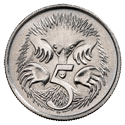Australian five-cent coin
Australia | |
| Value | 0.05 AUD |
|---|---|
| Mass | 2.83 g |
| Diameter | 19.41 mm |
| Thickness | 1.30 mm |
| Edge | Reeded |
| Composition | 75% Copper, 25% Nickel |
| Years of minting | 1966–present |
| Catalog number | — |
| Obverse | |
| Design | Queen Elizabeth II, Australia's Queen |
| Designer | Ian Rank-Broadley |
| Design date | 1999 |
| Reverse | |
 | |
| Design | Echidna |
| Designer | Stuart Devlin |
| Design date | 1966 |
The Australian five-cent coin was the third-smallest denomination coin of the decimal Australian dollar introduced in 1966. Since the withdrawal from circulation of the one and two cent coins in 1992 it has been the lowest-denomination coin in the country.
The coin was introduced into circulation on 14 February 1966. In its first year of minting, 30 million were struck at the British Royal Mint (then in London) in addition to 45.4 million at the Royal Australian Mint in Canberra. Since then, the coin has been produced exclusively at Canberra, apart from in 1981. In that year, 50.3 million were produced at the Royal Mint's new headquarters in Llantrisant, Wales; as well as 50 million from the Royal Canadian Mint in Winnipeg in addition to 62 million from Canberra.[1] The reverse side depicts an echidna and the obverse side the head of state, Queen Elizabeth II. The only commemorative coin in this denomination was issued in 2016 to commemorate the 50th anniversary of decimal currency.[2]
This coin has the highest mintage of any current coins and doesn't circulate well because of its value, like the one-euro cent. The lowest minted year is 1972 with 8.25 million coins and the highest was 2006 with 306.5 million,[3] and the average today is 80 million coins per year. No coins were issued in 1985-86 with the former valued at $30 uncirculated.
There has been some debate about removing this coin from circulation, like in the New Zealand dollar mainly as stated for its low value and high costs. On 23 May 2009 Fairfax newspapers reported that the Royal Australian Mint planned to scrap the coin.[4]
In May 2007, owing to the high market value of copper and nickel, the bullion value of the coin was about 6.5 cents, though there were no reported cases of hoarding or melting down of the coins despite the apparent 30% gross profit to be made from doing so. Market prices as at October 2008 were about $7/kg for copper and $17/kg for nickel, making the metal content of the 5 c coin worth only 2.7 c or 54% of its face value (the same as for a 10 c or 20 c coin). Base-metal prices have dropped further since.
See also
References
- Ian W. Pitt, ed. (2000). Renniks Australian Coin and Banknote Values (19th ed.). Chippendale, NSW: Renniks Publications. ISBN 0-9585574-4-6.
- ^ https://www.ramint.gov.au/five-cents
- ^ "Royal Australian Mint: 5 cents". Retrieved 10 September 2016.
- ^ Mintage figures from the Royal Australian Mint 1966-2009
- ^ Hirst, David (23 May 2009). "Get your 5c worth before it goes out of circulation". Sydney Morning Herald. Retrieved 23 May 2009.
